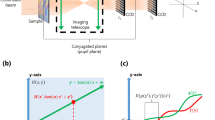Abstract
THE problem of surface reflexion from lenses has led1 to the development of multilayer interference structures which can suppress the reflexion from glass surfaces by a factor of 10 or more throughout the visible spectrum. But observations on the corneas of nocturnal insects indicate that nature may have anticipated the problems2. Electron microscope studies of the corneal lenses of moths reveal that the outer surface is covered in a regular array of conical protuberances, typically of about 200 nm height and spacing. Bernhard2 proposed that the function of this structure might be to suppress reflexions by effectively proving a graded transition of refractive index between the air and the cornea. The proposal was substantiated by measurements with microwave radiation reflected from a model of the array, scaled up appropriately for the longer wavelengths.
This is a preview of subscription content, access via your institution
Access options
Subscribe to this journal
Receive 51 print issues and online access
$199.00 per year
only $3.90 per issue
Buy this article
- Purchase on Springer Link
- Instant access to full article PDF
Prices may be subject to local taxes which are calculated during checkout
Similar content being viewed by others
References
Cox, J. T., and Hass, G., in Physics of Thin Films (edit. by Hass, G., and Thun, R. E.) 2, 239 (Academic Press, New York, 1964).
Bernhard, C. G., Endeavour, 26, 79 (1967).
Auton, J. P., and Hutley, M. C., Infrared Phys., 12, 95 (1972).
Lord Rayleigh, Lond. Math. Soc., 11, 51 (1880).
Author information
Authors and Affiliations
Rights and permissions
About this article
Cite this article
CLAPHAM, P., HUTLEY, M. Reduction of Lens Reflexion by the “Moth Eye” Principle. Nature 244, 281–282 (1973). https://doi.org/10.1038/244281a0
Received:
Issue Date:
DOI: https://doi.org/10.1038/244281a0
This article is cited by
-
Synthetic brochosomes: design, synthesis, and applications
Nano Research (2024)
-
Biomimetic sapphire windows enabled by inside-out femtosecond laser deep-scribing
PhotoniX (2022)
-
A template-free, more environmentally friendly approach for glass micro-texturing
Scientific Reports (2022)
-
Advanced damage-free neutral beam etching technology to texture Si wafer with honeycomb pattern for broadband light trapping in photovoltaics
Journal of Materials Science: Materials in Electronics (2021)
-
Fabrication of perovskite solar cell with high short-circuit current density (JSC) using moth-eye structure of SiOX
Nano Research (2020)
Comments
By submitting a comment you agree to abide by our Terms and Community Guidelines. If you find something abusive or that does not comply with our terms or guidelines please flag it as inappropriate.



